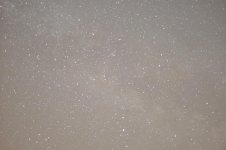Jack Dickens
New member
Greetings fellow Nikon users!
I recently purchased an iOptron SkyTracker in hopes of doing some nifty dark sky photography. Not star trails, but some milky way type shots and possibly some deep space stuff.
The SkyTracker will allow me to 'follow my target' without getting the trails normally associated with leaving the shutter open for long periods at night.
I am using a D90 with the 18-70mm kit lens off my old D70.
Can anyone help me with what settings I should be using on my camera to get the best possible milky way type shots? Any suggestions will be GREATLY appreciated!
I recently purchased an iOptron SkyTracker in hopes of doing some nifty dark sky photography. Not star trails, but some milky way type shots and possibly some deep space stuff.
The SkyTracker will allow me to 'follow my target' without getting the trails normally associated with leaving the shutter open for long periods at night.
I am using a D90 with the 18-70mm kit lens off my old D70.
Can anyone help me with what settings I should be using on my camera to get the best possible milky way type shots? Any suggestions will be GREATLY appreciated!

